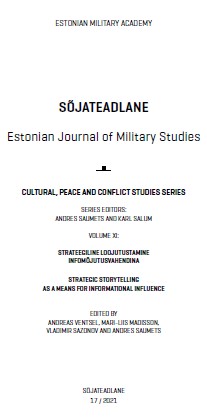EESTI JA NATO KÜBERKAITSEVÕIME NARRATIIVNE KONSTRUEERIMINE EESTI AJAKIRJANDUSVÄLJAANNETES
A CONSTRUCTION OF NARRATIVES ON ESTONIAN AND NATO CYBER DEFENCE CAPABILITIES IN ESTONIAN JOURNALISM
Author(s): Maia KlaassenSubject(s): Media studies, Security and defense, Politics and communication, ICT Information and Communications Technologies
Published by: Kaitseväe Akadeemia (KVA)
Keywords: information disorders; strategic narratives; national cyber security; securitization; media and information literacy; resilience of society;
Summary/Abstract: The objective of this article is to outline the ways in which the media constructs the ability of Estonia and NATO to resist e-threats from international actors and the changed information environment. I wanted to describe the thematic narratives, the manner in which the characters and activities are portrayed, and determine which narratives featured signs of securitisation. For this purpose, I searched for articles published in the Estonian media before, during, and after the cyber security incidents of 1 November 2020 and 31 March 2021, using predetermined keywords with the Station. ee media monitoring tool. After constructing the sample, I analysed 109 thematic articles from various publications and encoded them with MaxQda software. From these publications, I identified 11 narratives and divided them into four thematic clusters: hybrid threats from Russia (1. “Information war is particularly dangerous in Russia’s case, as it is a precursor for military aggression,” 2. “The West is overly paranoid about Russia’s propaganda machine,” and 3. “Russian information operations have convinced many that Sputnik is the only safe vaccine.”), an expansion of Chinese resources and influence (4. “China applies spying, manipulation, and economic power to avoid criticism on human rights’ violations,” 5. “Technological advancements make China a dangerous superpower,” and 6. “China aims to export and realise the party’s authoritarian values internationally.”), the weakened international status of Estonia as an e-state (7. “Estonia has failed as an e-state because not enough e-solutions were used during the pandemic,” and 8. “Estonia lacks a political will to adequately coordinate information security.”), and modern information environment as a global security threat (9. “Radicals prepare themselves in the cyberspace and go on to wreak havoc in the physical world,” 10. “Information environment has made spying and attacking national systems easy and catching criminals hard,” and 11. “NATO has not been able to adequately adapt with the new strategic environment.”). Since narratives can be fragmented and intertwined in media texts, a narrative analysis is often subjective and open to interpretation by a researcher. In order to mitigate this risk, I asked some experts in the defence field to evaluate the narratives: whether these are new or developed from earlier narratives, which party could benefit from their spreading, and whether the narratives are efficient.
Journal: Sõjateadlane
- Issue Year: 2021
- Issue No: 17
- Page Range: 195-229
- Page Count: 35
- Language: Estonian

